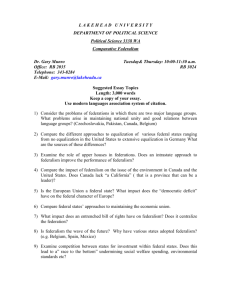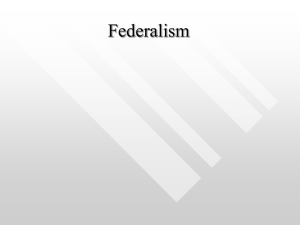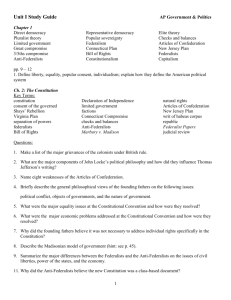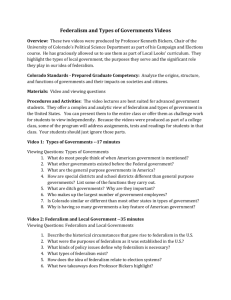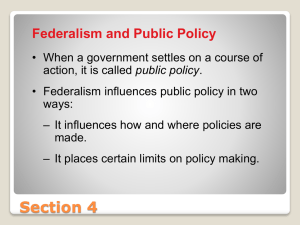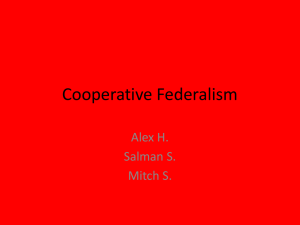Federalism: Theory and Practice
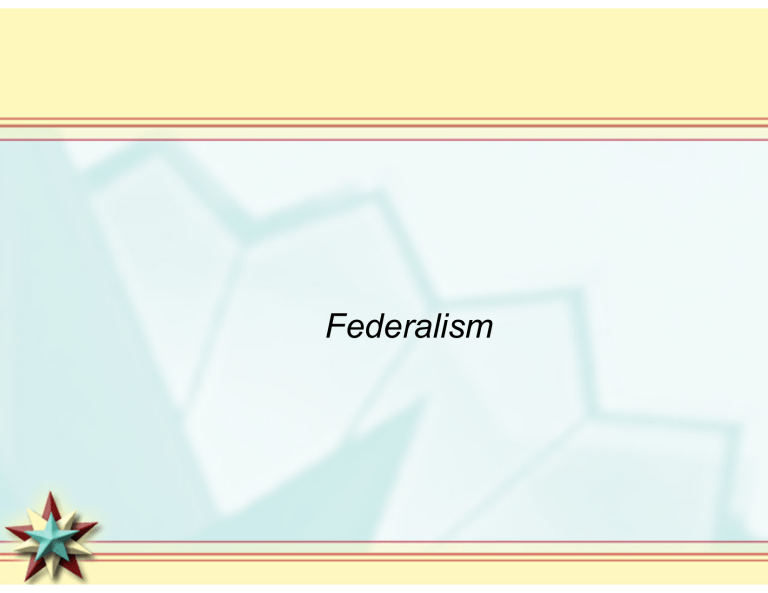
Federalism
Theories and Metaphors
• Citizens’ fears that majorities with different interests and values would rule them were calmed by the creation of federalism.
• Federalism is the division of power between a central government and regional governments. Two or more governments exercise power and authority over the same people and the same territory.
Theories and Metaphors
• Dual Federalism (layer-cake federalism) is a view that holds the Constitution is a compact among sovereign states, so that the powers of the national governments and the states are clearly differentiated.
Dual Federalism’s Components
• The national government rules by enumerated powers only,
• The national government has a limited set of constitutional purposes,
• Each government unit—nation and state—is sovereign within its sphere
• The relationship between nation and states is best characterized by tension rather than cooperation.
Theories and Metaphors
• Also of primary importance in dual federalism are states’ rights —the idea that all rights not specifically conferred on the national government by the
Constitution are reserved to the states.
Metaphors for Federalism
Theories and Metaphors
• Cooperative Federalism (marble-cake federalism) is a different theory of the relationship between state and national governments
• Acknowledges the increasing overlap between state and national functions and rejects the idea of separate spheres, or layers, for the states and the national government.
Cooperative Federalism’s Components:
• National and state agencies typically undertake government functions jointly rather than exclusively
• The nation and states routinely share power
• Power not concentrated at any government level or in any agency
• Fragmentation of responsibilities gives people and groups access to many venues of influence.
Federalism’s Dynamics
• The actual and proper balance of power between the nation and states has always been more a matter of debate than of formal theory.
The Elastic Clause
• “Necessary and proper” clause
• Gives Congress the power to make all laws that are necessary and proper to carry out its responsibilities.
• Congress often uses this power to increase the scope of the national government.
Federalism’s Dynamics
• The rulings of the federal courts have influenced the relationship between the national government and the states.
• The Supreme Court’s determination regarding the Commerce Clause , Article I, Section 8, of the Constitution, gave Congress the power to regulate commerce among the states.
Federalism’s Dynamics
• During the New Deal and after the Great
Depression, court rulings upheld several major New Deal measures and voter’s seeming endorsement of the economic crisis as a national problem that demanded national action.
Federalism’s Dynamics
• In the 1990s and afterward, however, a series of Supreme Court rulings involving the commerce clause and rulings concerning gun control legislation, among others, suggested that the states’ rights position was gaining ground.
Types of Grants
• Federal incentives such as the Grant-in-
Aid , money provided by one level of government to another to be spent for a given purpose, have influenced the federal government’s control over states.
• So too have categorical grants , grantsin-aid targeted for a specific purpose either by formula or by project
Categorical Grants
• Formula Grants —categorical grants distributed according to a particular set of rules, called a formula, which specify who is eligible for the grants and how much each eligible applicant will receive
Categorical Grants
• Project Grants —categorical grants awarded on the basis of competitive applications submitted by prospective recipients to perform a specific task or function.
Block grants
• In contrast to categorical grants
• Grants-in-aid awarded for general purposes , allowing the recipient great discretion in spending the grant money.
Trends in National Government Grants to States and
Localities, FY 1980, 1990, and 2000
Federalism’s Dynamics
• A final important factor that has produced dynamic changes in the American federal system has been the emergence of state governments as more capable policy actors.
Ideology, Policymaking, and American
Federalism
• Citizens, interest groups and officials inside government who attempt to persuade others to accept a particular view of the proper balance between freedom, order and equality and who champion particular policy ideas are known as policy entrepreneurs .
Ideology, Policymaking, and American
Federalism
• The existence of national and state governments, along with their executive, legislative and judicial branches and their bureaucratic agencies, offer these entrepreneurs many different venues to attempt to influence policy and politics .
Ideology, Policymaking, and American
Federalism
• Conservatives are often associated with the layer-cake metaphor because they are frequently portrayed as believing that different states have different problems and resources and that returning control to state governments would actually promote diversity.
Ideology, Policymaking, and American
Federalism
• Liberals, associated more with the marblecake approach, believe the states remain unwilling or unable to protect the rights or to provide for the needs of their citizens.
Ideology, Policymaking, and American
Federalism
• The power of Congress to enact laws by which the national government assumes total or partial responsibility for a state government function is termed preemption .
Ideology, Policymaking, and American
Federalism
• Preemption infringe on state powers in two ways:
• Mandates —a requirement that a state undertake an activity or provide a service, in keeping with minimum national standards
• Restraints —a requirement laid down by an act of Congress, prohibiting a state or local government from exercising a certain power.
Federalism and Electoral Politics
• Federalism plays a significant role in electoral politics.
• State capitals often serve as proving grounds for politicians who aspire to national office.
Redistricting
• The process of redrawing political boundaries to reflect changes in population, reveals crucial connections between all levels of government.
Federalism and the American
Intergovernmental System
• The presence of local government units help to illustrate that there is a growing recognition among public officials and citizens that public problems cut across governmental boundaries.
Types of Local Governments
• Municipal Governments: The government units that administer a city or town.
• County Governments: The government units that administer a county.
Types of Local Governments
• Special Districts: Government units created to perform particular functions, especially when those functions are best performed across jurisdictional boundaries
• Home Rule: The right to enact and enforce legislation locally.
Federalism and the International System
• American federalism can have important impacts on how the U.S. deals with other nations.
• For example, the federal government commands significant capacity to act in trade policy.
Federalism and the International System
• Scholars note that the U.S. may be moving from a world of sovereign nationstates to a world of diminished state sovereignty and increased interstate linkages of a constitutionally federal character.
• Example: the European Union where individual federations, unions and unitary states have “pooled their sovereignty.”
Federalism and Pluralism
• The layer-cake approach of dual federalism aims to maintain important powers in the states and to protect those powers from an aggressive or assertive national government.
Federalism and Pluralism
• The marble cake of cooperative federalism sees relations between levels of government in more fluid terms and is willing to override state standards for national ones, depending upon the issues at stake.
The Growth of National Government
Why has the power of the national government grown over the last two centuries?
Industrialization
Great Depression
WWII
Political leaders’ promotion of federal initiatives
Evidence or
Unitary or Federal?
Let’s look at the struggle between states and the feds—starting with the feds—it can be the boss by using sticks or carrots
Mandates or "sticks"
The supremacy clause means they trump—so they can tell the states what to do--
Of course it must be acting in its “sphere” of enumerated powers found where?
And even more expansively, within its implied powers made possible the what clause?
EXAMPLE: Most environmental legislation
(States are told: Clean up the air . . period).
Clean Air Act
Example: Civil Rights Legislation
Remember: if the feds are mandating something, they must be acting within their “sphere”
Separate but equal drinking fountains are bad . . . But that is not the question here—the question is can
Congress do anything about it?
Is it within their “enumerated powers sphere?
And the “umpire” upholds it:
In Heart of Atlanta Motel v. United States (1964), the Court ruled that Congress could regulate a business that served mostly interstate travelers; in Katzenbach v. McClung (1964) the Court ruled that the government could regulate Ollie's Barbecue, which served mostly local clientele but sold food that had previously moved across state lines; and in Daniel v. Paul (1969), the Court ruled that the government could regulate a recreational facility because three out of the four items sold at its snack bar were purchased from outside the state.
Another Example: Americans with Disabilities Act
Americans with Disabilities Act—States (and businesses) may not discriminate in employment and state and local governments must provide equal access to service, employment , buildings and transportation—
Important note: Mandates can be funded . . . Or they can be partially funded . . . Or they can be unfunded . . . But they are a stick—the states must do it. The ADA was unfunded.
No Child Left Behind was partially funded
It’s a mandate
And Utah refuses to comply with any parts that are unfunded
Then there is the carrot approach . . .
Carrots or strings attached to grants as "condition of aid "
These proliferated in 1970's tells state governments what they must do if they want money can apply just to a program---like if want highway money it must have a highway beautification plan, or what that has to do with drinking? or can cover all grants--if state builds anything with federal money, it must conduct an EIS. ("crosscutting)
CNN July, 1996: Louisiana's legislature was the last to raise the minimum drinking age to 21 in order to save
$14 million to $18 million per year in federal highway funds. In March, the state's highest court ruled that the minimum age hike was unconstitutional.
Fiscal Federalism
Fiscal Federalism is the power of the national government to influence state policies through grants
The Future of Federalism
During recent decades, state governments have become stronger than ever.
-Increasingly aggressive on economic and environmental matters
-Questionable effect on minority rights
Even so, the persistence of international terrorism, the wars in Afghanistan and
Iraq, and rising deficits all ensure a substantial role for the national government in the years to come.




